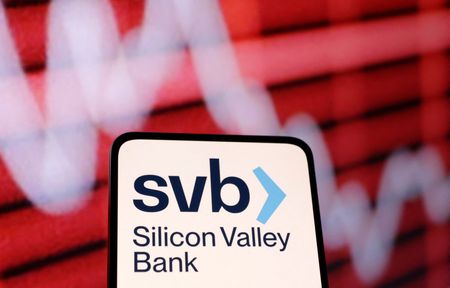
By Naomi Rovnick and Mehnaz Yasmin
LONDON (Reuters) – For months, investors had shrugged off the threat of rising interest rates. That changed this week.
U.S. tech specialists Silicon Valley Bank’s failed scramble for fresh capital, after losing $1.8 billion selling a package of bonds to meet depositor demands for cash, sparked a global rout in bank stocks – and a rethink.
In SVB’s case, venture capital clients, unable to raise cash elsewhere, pulled money from the bank, forcing its hasty sale of bonds at a loss.
While the SVB case may be exceptional, banks everywhere face similar risks.
It’s a wake-up call not just for investors, who have until now largely shrugged off the rapid rise in interest rates, but also for banks, which are vulnerable to a sharp selloff in government bonds.
“This is the first moment since rates started to rise where systemic risk has really arisen,” said Florian Ielpo, head of macro at Lombard Odier Investment Managers.
“It’s just tremors of it so far but we need to be extra cautious.”
After more than a decade of economic life support by way of easy policy and the flooding of markets with trillions in cash that even spawned virtual crypto money, central banks are slamming into reverse.
Bonds and company shares suffered hefty losses last year as borrowing costs shot up, yet the resilience of major economies, as well as China’s post-pandemic reopening and an unexpected reverse in energy prices buoyed the general mood – until now.
(Graphic: The race to raise rates- https://www.reuters.com/graphics/GLOBAL-MARKETS/klvygnlbyvg/chart.png)
Major developed economies alone have lifted rates by more than 3,000 basis points in this tightening cycle, the fastest pace since the 1980s in a bid to tame prices.
Bets on further hikes have ratcheted up in recent days as inflation remains stubbornly high, with Federal Reserve Chair Jerome Powell on Wednesday reaffirming his message of higher and potentially faster rate hikes.
Unease triggered by SVB left European banking stocks nursing their biggest weekly losses since September and U.S. bank shares have slumped more than 11% this week, their biggest weekly drop since June 2020.
Demand for U.S. dollars in the currency derivative markets meanwhile surged on Friday, another sign of stress trickling through the system.
BANK WATCH
After triggering the great financial crash more than a decade ago through high-risk bets on housing loans, banks are now shooting back up the list of investor worries.
SVB’s loss on the sale of its $21 billion available-for-sale securities, consisting mostly of U.S. Treasuries, has sparked concerns about the bond portfolios of U.S. banks.
In February, U.S. regulators said U.S. banks had unrealised losses of more than $620 billion on securities, underscoring the scale of the risks.
(Graphic: Unrealized gains (losses) on investment securities- https://www.reuters.com/graphics/BANKS-UNREALIZED%20LOSSES/CHART/lbpggladopq/chart_eikon.jpg)
Banks are not required to immediately recognise paper losses on a bond, allowing some of these risks to slumber on their books.
Jason Benowitz, senior portfolio manager at CI Roosevelt, said SVB’s risks were not unique with many banks sitting on such unrealised losses because rates have moved so rapidly.
“Those aspects of the SVB crisis are common to the banking system more broadly,” he noted.
Bonds lose value when yields rise in a high rate environment. Smaller banks are at greater risk, analysts said.
U.S. benchmark 10-year yields surged by more than 200 basis points last year and almost 40 bps in February alone on renewed rate-hike bets.
“The SVB situation is a reminder that many institutions are sitting on large unrealised losses,” said AJ Bell investment research director Russ Mould.
Geoffrey Yu, senior EMEA market strategist at BNY Mellon, said investors could “take heart” from signs that the financial system has taken global rate hikes in its stride.
But he added “it’s a reminder that there is a repricing perhaps needed to reflect that higher rates do translate into loan losses and some banks will face stress”.
“It’s just a wake up call that there’s still a chance you will identify pockets of risk and that you will see loan losses and a rise in bankruptcies.”
(Additional reporting by Iain Withers and Nell Mackenzie in London; Writing by Dhara Ranasinghe and John O’Donnell; Editing by Kirsten Donovan)

